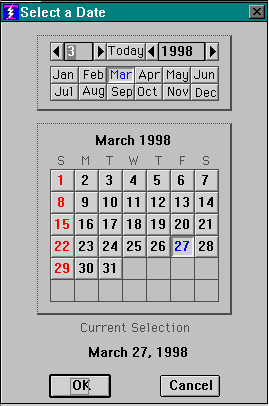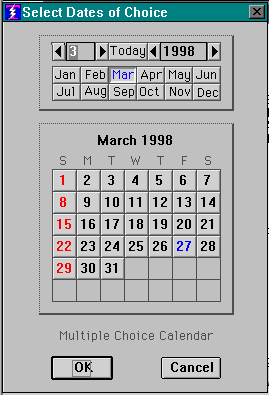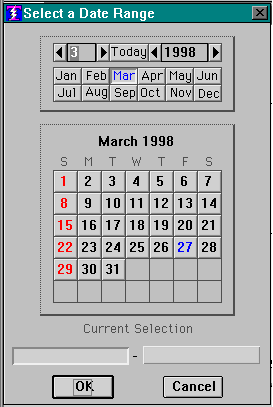

CALENDAR %DATE TITLE "Select a Date"
Form1 Calendarwith the K option invoked with:

CALENDAR/K %DATES TITLE "Select Dates of Choice"
Form2 Calendarfor a date range invoked with:

CALENDAR %DATE1 %DATE2 TITLE "Select a Date Range"
In each of these Calendars the user can click on any Month to establish that month, click on "Today" to restore the calendar to todays date, use the spinners to adjust the Month or Year. Or you can double-click on the year and enter any year from 1001 to 9999. To make a selection, click on a day.
The basis for the Calendar is the beginning of the last millennium: January 1, 1001. The Calendar is an extrapolation backwards of our current calendar method to that date, that is, it does not take into account the adjustment made in 1582 so that it would track the Sun better. (If you went to sleep on the night of October 4, 1582 you woke up on October 15, 1582. There were people who thought that the Pope had stolen two weeks out of their lives, but that is another discussion.)
There is an old English nursury rhime posited by A. E. Bray in 1832 that goes:
Mondays child is fair of face
Tuesdays child is full of grace
Wednesdays child is full of woe
Thursdays child has far to go
Fridays child is loving and giving
Saturdays child works hard for a living
And the Child born on the Sabbath day
is bonny and blithe and good and gay
It is interesting to see what a prognosticator that is for the millenniums. The last millennium, January 1, 1001 began on a Thursday - "Has far to go." That seems pretty accurate. The next millennium January 1, 2001 begins on a Monday - "Fair of Face." We think that is auspicious.
To see an example of a Calendar in action, try REPORTS/REVENUE/6 in the EXAMPLE data base.
Copyright © 2019 , WhamTech, Inc. All rights reserved. This
document is provided for information purposes only and the contents hereof are
subject to change without notice. Names may be
trademarks of their respective owners.